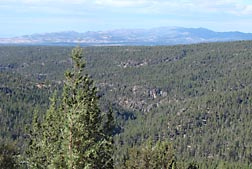Forum—Current Challenges Can Help Fuel Future Opportunities
Native juniper trees and invasive plants pose an expanding threat to the survival of the sagebrush ecosystem in arid western rangelands. As the trees mature, they compete with other native plants that are valuable food sources for wildlife and cattle. After these plants die back, the bare patches of soil that remain are vulnerable to erosion and encroachment from other species like cheatgrass, an invasive nonnative annual that fuels wildfires.
Wildfires threaten livestock ranches, are suppressed in large part by efforts funded with taxpayer dollars, and increase the probability that invasive plants will spread and thrive in the postfire landscape. So while western juniper, pinyon pine, and other similar native trees have a role to play in this ecosystem, the thickets that are rapidly spreading across the rangelands need to be brought under control.
Fortunately, the challenge these trees present to healthy rangelands also creates an opportunity for using them as a feedstock for renewable fuel production. And this new opportunity means that western states could significantly contribute to meeting national goals for the production of renewable bioenergy in the United States. Agricultural Research Service researchers already have a framework in place for tackling the many issues that need to be resolved before turning a tree into a gallon of renewable fuel. In 2010, U.S. Department of Agriculture Secretary Tom Vilsack created five Regional Biomass Research Centers to maximize existing USDA research resources for bioenergy development. The goal of this effort is to develop sustainable, regional approaches for producing feedstocks so that rural communities across the country have opportunities to participate in the emerging biofuels and biobased-products economy. (See "ARS and the Regional Biomass Research Centers," Agricultural Research, September 2012.)
One of the main challenges in producing domestic sources of bioenergy feedstocks is ensuring that we don't interfere with production of food and feed crops grown on prime farmland. We must also develop cost-effective production systems that not only protect soil resources and conserve water but also sequester carbon. Carbon dioxide is a greenhouse gas that contributes to long-term global warming but boosts crop productivity when accumulated in the soil as organic matter. Achieving these multiple beneficial outcomes is complicated by the fact that extreme weather events such as droughts and heat waves are already necessitating adjustments in current U.S. agricultural production systems.
ARS conducts ongoing research to identify management strategies to protect arid rangeland ecosystems and maintain their value for wildlife, livestock, and recreation. Looking for additional sustainable ways to manage and utilize invasive trees is simply introducing a new—and potentially lucrative—value-added component to land managers' toolboxes.
Using invasive junipers to make cost-competitive biofuels can help reduce wildfires and improve grazing for cattle and habitat for wildlife-including the sage grouse, which depends on the fragrant sagebrush to provide food, shelter, and a suitable backdrop for its legendary mating call and dance. With careful planning and cooperation, we can turn an arid rangeland challenge into a resource that will help us meet multiple national goals well into the new century.
Jeffrey J. Steiner
Former ARS National Program Leader
Biomass Production Systems
Beltsville, Maryland
"Forum" was published in the July 2013 issue of Agricultural Research magazine.







